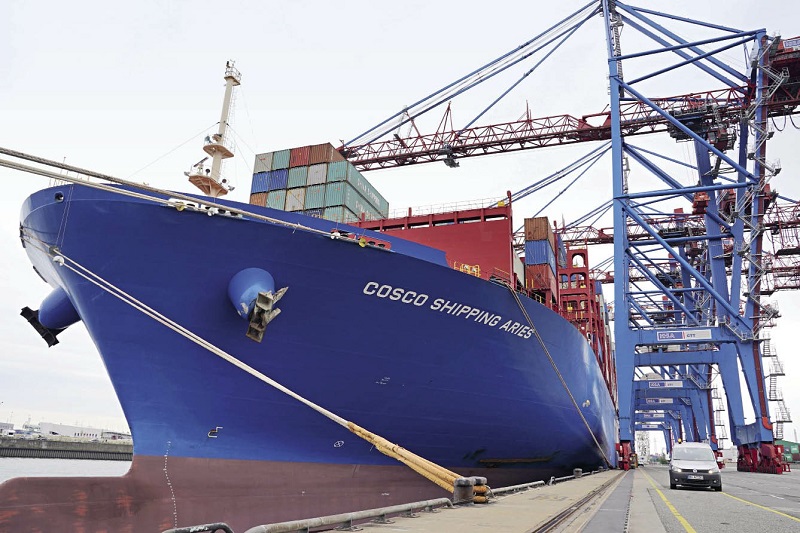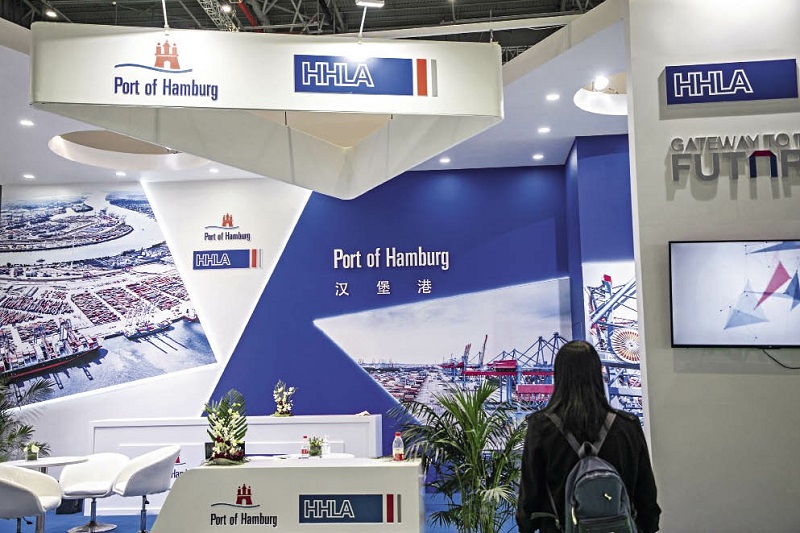The European transport hub is poised to have more cooperation with China through links of the Belt and Road.
The Port of Hamburg is one of Europe’s biggest hubs for trade with China. In 2020 alone, more than 2.4 million standard containers (TEU) were handled here. Nearly one-third of all containers passing through the seaport have China as their destination or origin. A total of 15 liner services connect Hamburg with all major Chinese ports.
One of the port’s main strengths is its connection to the European railway network, as no other port in Europe offers such an extensive coverage. The Port of Hamburg is the central hub for China’s traffic to link not only Germany, but Austria, Poland, the Czech Republic, Russia, Hungary, Slovakia, and Switzerland.
Both the Hamburg Port Authority (HPA) and the companies in the port took the last year to further expand and modernize the infrastructure and equip handling facilities with the latest technology. The major terminal operators Hamburger Hafen und Logistik AG (HHLA) and EUROGATE invested in additional container gantry cranes for the handling facilities at Waltershofer Hafen. The container terminals in Hamburg are thus fully equipped to handle ultra large container ships, which can now reach the port more easily. The fairway adjustment was completed in February this year. The passing box, built jointly by the HPA and the Federal Waterways and Shipping Administration, can now be used over the entire area. The Elbe fairway has been widened to 385 meters along the eight kilometers between Wedel and Blankenese. As of today, seagoing ships with a combined width of 104 meters – instead of the former 90 meters – will safely be able to pass each other.

Port of Hamburg, one of Europe’s major hubs for trade with China, has extensive connections with the European railway network.
All parties in and around the Port of Hamburg are constantly working on digitalizing the physical transport chains. Digital transport processes ensure a much smoother connection between sea and hinterland traffic. This benefits all players in the port – from the terminal operator to railway undertakings. Process automation also ensures even greater efficiency by means like deploying automated guided vehicles at the terminals. Intelligent traffic routing ensures a more efficient traffic flow not only on the roads and railways, but also on the river.
The Port of Hamburg is the source or destination for approximately 38 percent of national rail freight traffic. For the German railway infrastructure operator DB Netz, northern Germany is the most important investment area and work is continuously carried out to repair and modernize the surrounding infrastructure. Germany’s largest railway port is thus not only optimally connected to the national rail network, but also to the European and Russian networks.
In 2020 Hamburg’s seaport-hinterland transport by rail accounted for a volume of 46.6 million tons and 2.6 million TEU, remaining fairly stable. The 4.4 percent decrease in containers transported by rail was considerably smaller than the drop in container throughput as a whole. “In terms of volume, 2020 was the third-best year, and in terms of the number of containers carried it was the second-best year in the history of the Hamburg Port Railway.”
On the tracks of the Hamburg Port Railway, approximately 200 freight trains with 5,500 wagons are handled rapidly and efficiently every day. There are now more than 160 rail operators that use these tracks, with a dense network of wagon load traffic as well as shuttle and block train connections throughout Europe. Every week, there are nearly 2,000 connections to and from Hamburg – among which over 230 per week are with China. The Chinese cities including Changchun, Changsha, Chengdu, Chongqing, Dalian, Ganzhou, Harbin, Hefei, Jinan, Shenyang, Shenzhen, Shilong, Suzhou, Weihai, Wuhan, Xiamen, Xi’an, Yantai, Yiwu, and Zhengzhou are linked to Hamburg by regular train services. In November 2020 and April 2021 respectively, two more connections between Hamburg and Chinese cities Xuzhou and Shijiazhuang were added. Throughput on intercontinental rail traffic between Hamburg and China alone increased by at least seven percent in 2020, bringing the total volume to 107,000 TEU. Up to 40 trains per week are meanwhile running between various provinces in China and Europe’s largest rail port. The Belt and Road provides an important addition to seaborne services on the global supply chain between China and Germany. Positive developments show that the services offered are warmly received.
In Hamburg, there are four terminals in total that handle rail cargo via the new Silk Road: DUSS Terminal Hamburg-Billwerder, Kombi-Transeuropa Terminal Hamburg at HHLA Container Terminal Altenwerder, Eurokombi and C. Steinweg.
The Hamburg Port Railway is the link between the cargo terminals and the European rail network. Whether the goods are transported from the port to different corners of the world or vice versa, the port railway provides the necessary infrastructure for every rail transport company that wants to access the Port of Hamburg. In recent years, important strategic expansion projects have been completed that are significant for the entanglement of transport in the Port of Hamburg.
Although rail freight transport still lags behind its maritime counterpart in terms of the volume of goods transported, it definitely plays an important role in boosting economic relations and trade between China, Germany, and other European countries. The signs are good. More trains and ships are making the Port of Hamburg their destination or starting point. The economic forecast, especially for German-Chinese business relations, is very good, as you hear from many institutions.

The exhibit booth for Port of Hamburg at the third China International Import Expo held in November 2020.
Many large logistics companies based in Hamburg, such as Dachser, Kühne+Nagel, or Hellmann, were already making intensive use of the transport routes of the Belt and Road before the COVID-19 pandemic. Due to the suspended scheduled connections and the limited capacities in air freight during the pandemic, the demand for train connections also increased in the Port of Hamburg. The first train from Jinan, for example, arrived at the DUSS Hamburg-Billwerder rail terminal in April 2020 in the midst of the pandemic. We were able to get medical supplies to Hamburg very quickly during the crisis via the train connections. Thanks to the excellent connections to the European hinterland, Hamburg plays a valuable part in supplying the population with relief goods and keeping the shelves in the supermarkets full, both by waterway and by rail. Thanks to donations from friends and partners in China, HHM was able to supply several businesses in the Port of Hamburg with respirators when there were capacity constraints in Germany in 2020.
Port and rail operations at Germany’s largest multipurpose port were able to continue as planned without disruption during the pandemic. As Europe’s largest railway port and Germany’s third largest inland port, Hamburg has great importance for supplying the population and the economy in Germany. At the beginning of the pandemic, all parties in the Hamburg port successfully rose to the challenge to keep the port running without interruptions. However, since the beginning of the year, hardly any ships have reached the Port of Hamburg on time. The delayed arrival of ships is not only due to the global pandemic and its consequences, but also due to other factors as unfavorable weather during the winter months and Brexit. The Suez blockade then exacerbated the situation. However, the major terminal operators in Hamburg have adjusted their operations to the situation and are able to react flexible to sudden changes.
Naturally, its excellent position as a transport hub also contributes to all rail connections with China. We see that there is further potential for growth. Hamburg and its logistics companies are in any case prepared to further intensify cooperation with partners and friends from China.
Thanks to the representative offices of the Port of Hamburg in Shanghai and Hong Kong, it was also possible to participate in important events and trade fairs in China despite the COVID-19-related travel restrictions, for example the China International Import Expo. In addition, the Hamburg Liaison Office releases updates every week on their social media about the Port of Hamburg as an important hub along the Belt and Road for China-Europe Railway Express.
AXEL MATTERN is chief executive officer of the Port of Hamburg Marketing.